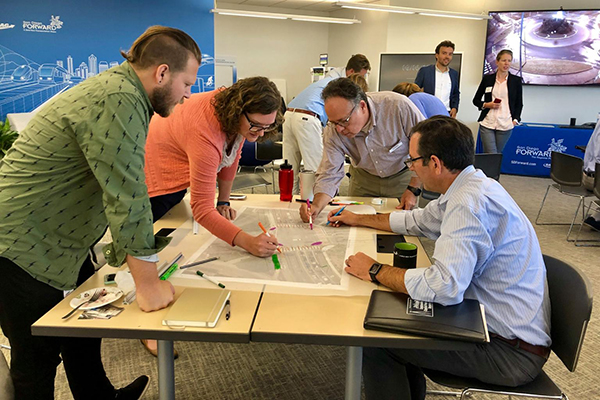Cycle culture / Cycling infrastructure / Education / Urban Mobility Design / Walking / Workshop
Building Capacity on America's West Coast
As we continue to build our presence in the North American market, it is crucial to the success of our business development to ensure we have an understanding of the varying perspectives that make up Canada and the USA. It was this mindset that inspired Lennart Nout, Manager of International Strategy, and Mary Elbech, US Lead and Integrated Mobility Consultant, to coordinate a tour of some of America’s West Coast cities. While the principles of good, safe street design are fairly straightforward, how they are applied to a given community can really vary, and by visiting, learning from and bringing our expertise to places like Portland, Eugene and San Diego, we can gain a better appreciation for the challenges they are facing. It also provides an opportunity to bring our Dutch-inspired thinking to these places to help inspire better design.

Rethinking our approach: A new perspective at APBP in Portland
Each year the Association of Pedestrian and Bicycle Professionals hosts a conference bringing together professionals from throughout North America working in the field. This year’s event was held in Portland, Oregon, long considered America’s Bike Capital. But bicycle-friendliness aside, Lennart and Mary saw an incredible value in connecting with their industry peers.
“APBP is a great community of people really pushing the envelope in the US and Canada,” states Mary. “Attending the conference is a great way for us to gauge what’s going on and see how we can better adapt our Dutch approach to the market.” Along with running two workshops, including a walkshop with the City of Portland’s Nick Falvo, Mary and Lennart attended a number of inspiring sessions that challenged them to see some mobility challenges in a different light. For example, they were both well-versed in the quick adoption and growth of the e-scooter market, but were surprised to hear studies reporting that 40% of e-scooter users are new to active transportation. “Understanding this helps us rethink how we approach these varying modes.”
Of particular note was the keynote presentation by Keith Benjamin “Real Change at the Intersections”. He focused on the role equity needs to play in addressing mobility needs and how important it is in the North American context. “It is so valuable to get a better understanding of how equity influences transportation in North America,” Lennart explains.
A fresh look on setting priorities
Following an inspiring week at APBP, Lennart and Mary set off to Eugene, Oregon where they had been invited to provide two workshops focusing on Traffic Calming and Protected Intersections. When it comes to traffic calming, while the City of Eugene has already created a number of successful neighbourhood greenways, they were interested to learn more about how to calm traffic on medium and high volume streets. “The best way to approach this is by taking a bigger picture view of the entire network,” says Mary. How reduced speeds, capacity or treatments are used in one area will have knock on effects to other parts of the network, so the goal of the team was to communication how important it is to take a step back.
Meanwhile, with cities everywhere recognizing the increased need for separation at intersections, the second workshop honed in on cycle- and pedestrian-friendly intersections and roundabouts. They looked at the principles of design employed in the Netherlands, with a frank explanation of common mistakes to avoid if the goal is to create safe corridor design. “The participants appreciated the fresh look at setting the right priorities and what is means to design a successful network,” Lennart notes. The team were really impressed with how representatives from departments spreading across the planning and engineering departments were in attendance, and how well they weren’t working in silos. It showed they were open to thinking outside the box to achieve their shared vision of where the city should go.
Building on a New Relationship
Mary and Lennart followed up their time in Oregon with a trip south to California, of course with a few picturesque stops along the way. Their final destination took them to San Diego, where they delivered a workshop for SANDAG, the regional planning agency and a new Mobycon partner. Titled Advanced Topics in Intersection Design, the interactive program provided staff an opportunity to look at how they might adapt and change their approach to street design to be more human-scaled.
Both Lennart and Mary feel the experience was incredibly worthwhile not just in connecting with existing and new partners. “By visiting these places and talking with people, you learn about local policies and bylaws and what restrictions people are working with,” Mary points out. North American cities are quite diverse in their approaches, and to be a successful partner to our clients, we need to be able to adapt ours to match their policies and bylaws to create achievable projects. Lennart sees this as a great opportunity for Mobycon: “In experiencing these places, we gain insight into their thinking, and see where it is that they need us to provide better advice, all for inspiring the best outcomes.”
Interested in organizing a workshop or training session focused on traffic calming, protected intersections or content catered to your capacity building needs? Contact Mary Elbech

